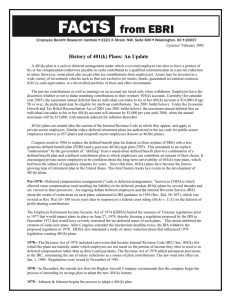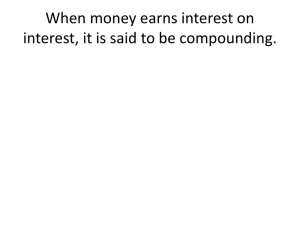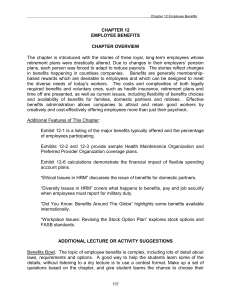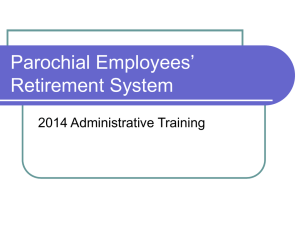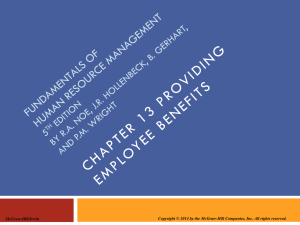Building a Retirement Program
advertisement
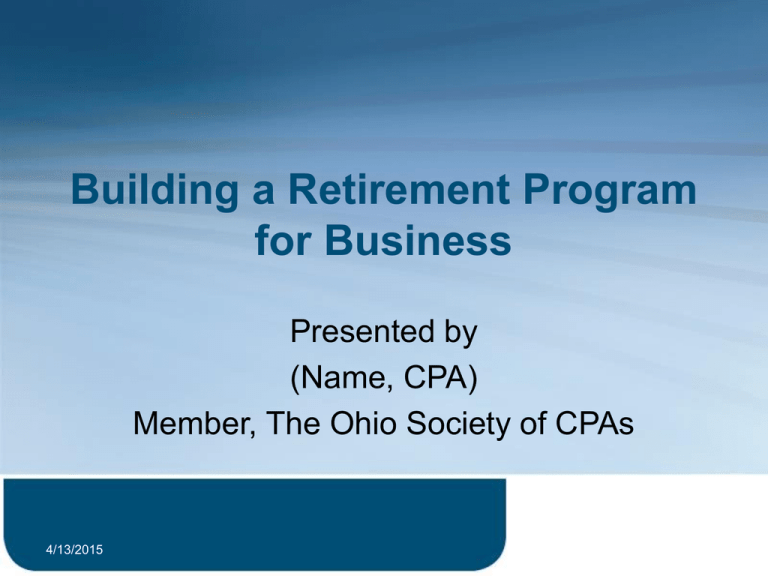
Building a Retirement Program for Business Presented by (Name, CPA) Member, The Ohio Society of CPAs 4/13/2015 1 Types of Retirement Plans • • • • • • • 4/13/2015 Payroll Deduction IRAs SEPs SIMPLE IRAs 401(k) Plans Profit-Sharing Plans Money Purchase Plans Defined Benefit Plans 2 Payroll Deduction IRA • Available to any size business, even the self-employed • Easy to set up and operate • Low administrative costs • Only your employees make contributions • Employers are only responsible for transmitting the employee’s authorized deduction to the financial institution 4/13/2015 3 Simplified Employee Pension Plan (SEP) To establish a SEP, you: • Can be a business of any size, even self-employed • Must adopt a SEP plan document • Generally can’t have any other retirement plan 4/13/2015 4 Simplified Employee Pension Plan (SEP) Advantages: • Easy to set up and operate – usually just a phone call to a financial institution gets things started • Low administrative costs • Flexible annual contribution obligations – great if cash flow is an issue 4/13/2015 5 SIMPLE IRA Plan To establish a SIMPLE IRA plan: • Have a business with, generally, 100 or fewer employees • Complete 1-2 forms • Can’t have any other retirement plan 4/13/2015 6 SIMPLE IRA Plan Advantages: • Easy to set up and run – usually just a phone call to a financial institution gets things started • Low administrative costs • Employees can contribute, on a tax-deferred basis, through convenient payroll deductions • Employers can match the employee contributions of those who decide to participate, or to contribute a fixed percentage of all eligible employees’ pay 4/13/2015 7 401(k) Plans • A 401(k) plan is a qualified profit-sharing, stock bonus, pre-ERISA money purchase pension or a rural cooperative plan. • It allows employees to elect to have the employer contribute a portion of the employee’s cash wages to the plan on a pre-tax basis. 4/13/2015 8 401(k) Plans Two of the tax advantages: • Employer contributions are deductible on the employer’s federal income tax return as long as the contributions do not exceed the limitations described in section 404 of the Internal Revenue Code. • Elective deferrals and investment gains are not currently taxed and enjoy tax deferral until distribution. 4/13/2015 9 401(k) Plans There are several types of 401(k) plans available: • Traditional 401(k) plans • Safe harbor 401(k) plans • SIMPLE 401(k) plans 4/13/2015 10 Traditional 401(k) Plans • Employees make pre-tax deferrals through payroll deductions • Employers have the option of making contributions • Employers must perform tests to verify the program doesn’t discriminate in favor of highly compensated employees 4/13/2015 11 Safe harbor 401(k) Plans • Similar to traditional 401(k) plans • Provides for fully vested employer contributions • Not subject to the complex annual nondiscrimination tests • Employers must satisfy certain notice requirements 4/13/2015 12 SIMPLE 401(k) Plans • Created for small businesses with 100 or fewer employees • Provides for fully vested employer contributions • Not subject to the complex annual nondiscrimination tests • Employees eligible to participate in a SIMPLE 401(k) plan may not receive any contributions or benefit accruals under any other plans 4/13/2015 13 Profit Sharing Plans • Allow for other retirement plans • Are available to businesses of any size 4/13/2015 14 Profit Sharing Plans Pros and cons: • Greater flexibility – contributions are strictly discretionary, good if cash flow is an issue • Administrative costs may be higher than under more basic arrangements, though pre-approved plans are available that might cut costs 4/13/2015 15 Profit Sharing Plans Pros and cons: • Must be careful that benefits do not discriminate in favor of highly compensated employees • Employer contributions only 4/13/2015 16 Profit Sharing Plans Determining how contributions are divided Comp to Comp plan: • Calculate sum of total employee compensation • Determine what percentage is earned by each employee • Use that percentage to distribute contributions 4/13/2015 17 Money Purchase Plans With a money purchase plan, employers: • Must make a set contribution each year • Can have other retirement plans • Can be a business of any size • Can use pre-approved money purchase plans to cut down on administrative costs 4/13/2015 18 Money Purchase Plans Pros and Cons: • Can grow larger account balances than under some other arrangements • Administrative costs may be higher than under more basic arrangements • Need to test that benefits do not discriminate in favor of the highly compensated employees 4/13/2015 19 Money Purchase Plans Pros and Cons: • An excise tax applies if the minimum contribution requirement is not satisfied • Employer and/or employee can contribute 4/13/2015 20 Defined Benefit Plans Pros: • Significant benefits possible in a relatively short period of time • Employers can contribute (and deduct) more than under other retirement plans • Plan provides a predictable benefit 4/13/2015 21 Defined Benefit Plans Pros: • Plan can be used to promote certain business strategies by offering subsidized early retirement benefits • Can be combined with other retirement plans • Available for businesses of any size 4/13/2015 22 Defined Benefit Plans Cons: • Must have an enrolled actuary determine the funding levels and sign the Schedule B • Cannot retroactively decrease benefits • Most costly type of plan • Most administratively complex plan • An excise tax applies if the minimum contribution requirement is not satisfied 4/13/2015 23 Additional Resources This information is adapted from the IRS Retirement Plans Community. For additional resources and forms, visit www.irs.gov/ep. 4/13/2015 24 For Further Information For further information or assistance with retirement plans, please contact me: – Name – Company – Address – E-mail – Phone 4/13/2015 25

